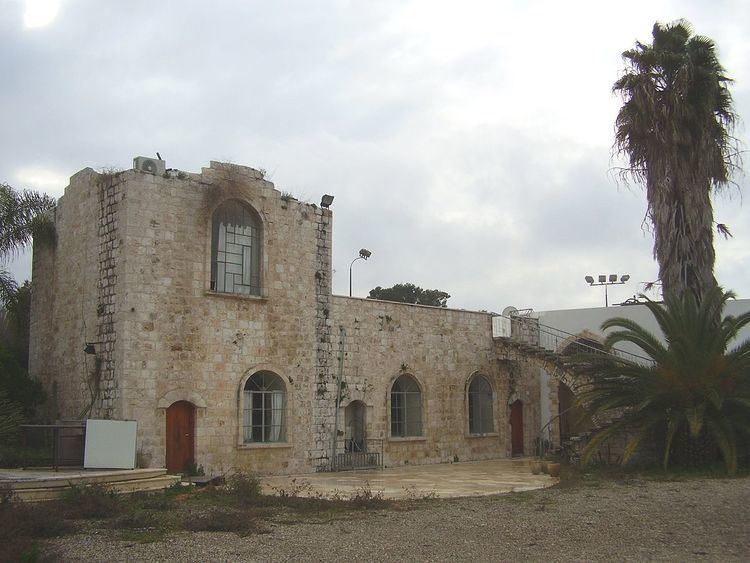Arabic وادي عارة Population 230 (1945) | Date of depopulation 27 February 1948 Palestine grid 153/209 | |
 | ||
Name meaning Khurbet ez Zebadneh=The ruin if the people of Zebdah Cause(s) of depopulation Fear of being caught up in the fighting Weather 18°C, Wind W at 13 km/h, 77% Humidity | ||
Wadi Ara (Arabic: وادي عارة) was an Arab village located 38.5 km south of the city of Haifa. It is named after the nearby stream that is known in Arabic as Wadi 'Ara. The village was particularly small with a population of 230 and a land area of approximately 9,800 dunums.
Contents
History
The archaeological site Tel al-Asawir was located northwest of the village site. Burial caves dating from the fourth to the second millennium B.C. were found there when the site was excavated in 1953.
The Muslim geographer Ibn Khurdadhbi (d. 912) described it as a stopping place on the road between al-Lajjun and Qalansuwa.
In 1882, the Palestine Exploration Fund's Survey of Western Palestine described it a small hamlet known as Khirbat al-Zabadna.
British Mandate era
In the British Mandate of Palestine- period, the village was classified as a hamlet in the Palestine Index Gazetteer. In the 1922 census of Palestine Wadi Arah had a population of 68; all Muslims, increasing in the 1931 census to 81; still all Muslim, in a total of 18 houses.
In 1945 Wadi Ara had a population of 230, with a total of 9,795 dunams of land. Of this, Arabs used 6,400 dunums of land for cereals, while 1,446 dunams were classified as uncultivable land.
1948 War and aftermath
During the 1948 Arab-Israeli War the village was successfully defended by Arab Liberation Army volunteers and Iraqi forces patrolling the nearby city of Tulkarm. All of the land the Iraqi Army controlled in Palestine including Wadi Ara was handed over to Jordan. Jordan under the command of King Abdullah I then ceded the entire Wadi Ara region to Israel on May 3, 1949. In March 1949 as the Iraqi forces withdrew from Palestine and handed over their positions to the smaller Jordanian legion, 3 Israeli brigades maneuvered into threatening positions in Operation Shin-Tav-Shin in a form of coercive diplomacy. The operation allowed Israel to renegotiate the cease fire line in the Wadi Ara area of the Northern West Bank in a secret agreement reached on 23 March 1949 and incorporated into the General Armistice Agreement. The green line was then redrawn in blue ink on the southern map to give the impression that a movement in the green line had been made.
The Jewish town of Ein Iron was built in 1934 on what were traditionally village land. Ma'anit, founded in 1942, is just south of the village site, but is not on village land. Kibbutz Barkai was established on the village site on May 10, 1949.
During the 1948/1949 war the locals in the area experienced violence at the hands of Israeli forces. A member of the Kibbutz Be'eri, assigned to the Guard Milices testified in a study undertaken by Israeli historian Yitzhaki and Uri Milstein: "We were in Wadi 'Ara. We raided a nearby Palestinian post and brought a prisoner for interrogation. A soldier beheaded him and scalped his head by knife. He raised the head on a pole to strike fear among Palestinians. Nobody stopped him."
Most non-Jewish residents were removed on February 27, 1948 prior to the official founding of the modern state of Israel, those remaining were removed by the end of July 1949.
The Palestinian historian Walid Khalidi described the remaining structures on the village land in 1992: "The site is occupied by Kibbutz Barqay. Only two village houses remain, both on the eastern edge of the site. One of them has arched windows and a spiral staircase leading up to a room on the roof. The second has a large entrance that is used today as a gate for the kibbutz's swimming pool."
Petersen inspected the remaining buildings in 1994, and described them as "a large rectangular building which appears to be of late Ottoman date. On the ground floor is a long hall (18.8m x 6.9m) roofed by three cross-vaults. On the upper floor is a large terrace and a single cross-vaulted room. South of this building are the remains of a high wall and a monumental gateway which now gives access to the Kibbutz swimming pool. It is likely that both buildings date to the latter part of the Ottoman period (i.e. 1880-1917)"
